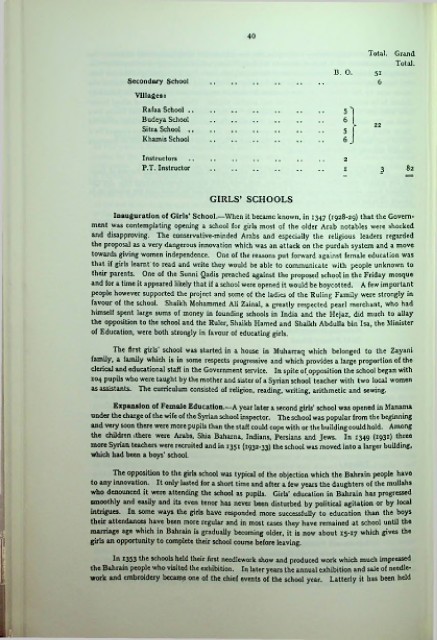Page 316 - Bahrain Gov Annual Reports (III)_Neat
P. 316
40
Total. Grand
Total.
B. 0. 5i
Secondary School 6
Villages 1
Rafaa School . 5*1
Budeya School 6
Sitra School . 5 22
Khamis School 6
Instructors
P.T. Instructor 1 3 82
GIRLS* SCHOOLS
Inauguration of Girls' School.—When it became known, in 1347 (1928-29) that the Govern
ment was contemplating opening a school for girls most of the older Arab notables were shocked
and disapproving. The conservative-minded Arabs and especially the religious leaders regarded
the proposal as a very dangerous innovation which was an attack on the purdah system and a move
towards giving women independence. One of the reasons put forward against female education was
that if girls learnt* to read and write they would be able to communicate with people unknown to
their parents. One of the Sunni Qadis preached against the proposed school in the Friday mosque
and for a time it appeared likely that if a school were opened it would be boycotted. A few important
people however supported the project and some of the ladies of the Ruling Family were strongly in
favour of the school. Shaikh Mohammed Ali Zainal, a greatly respected pearl merchant, who had
himself spent large sums of money in founding schools in India and the Hejaz, did much to allay
the opposition to the school and the Ruler, Shaikh Hamed and Shaikh Abdulla bin Isa, the Minister
of Education, were both strongly in favour of educating girls.
The first girls’ school was started in a house in Muharraq which belonged to the Zayani
family, a family which is in some respects progressive and which provides a large proportion of the
clerical and educational staff in the Government service. In spite of opposition the school began with
104 pupils who were taught by the mother and sister of a Syrian school teacher with two local women
as assistants. The curriculum consisted of religion, reading, writing, arithmetic and sewing.
Expansion of Female Education.—A year later a second girls’ school was opened in Manama
under the charge of the wife of the Syrian school inspector. The school was popular from the beginning
and very soon there were more pupils than the staff could cope with or the building could hold. Among
the children ithere were Arabs, Shia Bahama, Indians, Persians and Jews. In 1349 (x93x) three
more Syrian teachers were recruited and in I35x (1932-33) the school was moved into a larger building,
which had been a boys’ school.
The opposition to the girls school was typical of the objection which the Bahrain people have
to any innovation. It only lasted for a short time and after a few years the daughters of the mullahs
who denounced it were attending the school as pupils. Girls' education in Bahrain has progressed
smoothly and easily and its even tenor has never been disturbed by political agitation or by local
intrigues. In some ways the girls have responded more successfully to education than the boys
their attendances have been more regular and in most cases they have remained at school until the
marriage age which in Bahrain is gradually becoming older, it is now about 15-17 which gives the
girls an opportunity to complete their school course before leaving.
In 1353 schools held their first needlework show and produced work which much impressed
the Bahrain people who visited the exhibition. In later years the annual exhibition and sale of needle
work and embroidery became one of the chief events of the school year. Latterly it has been held
I

